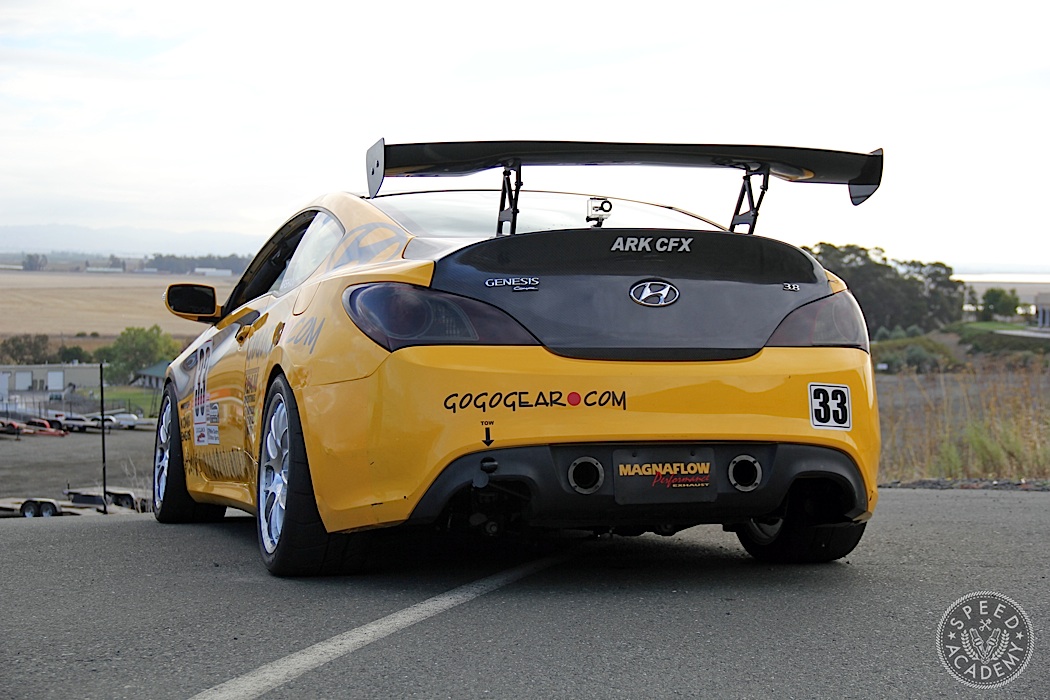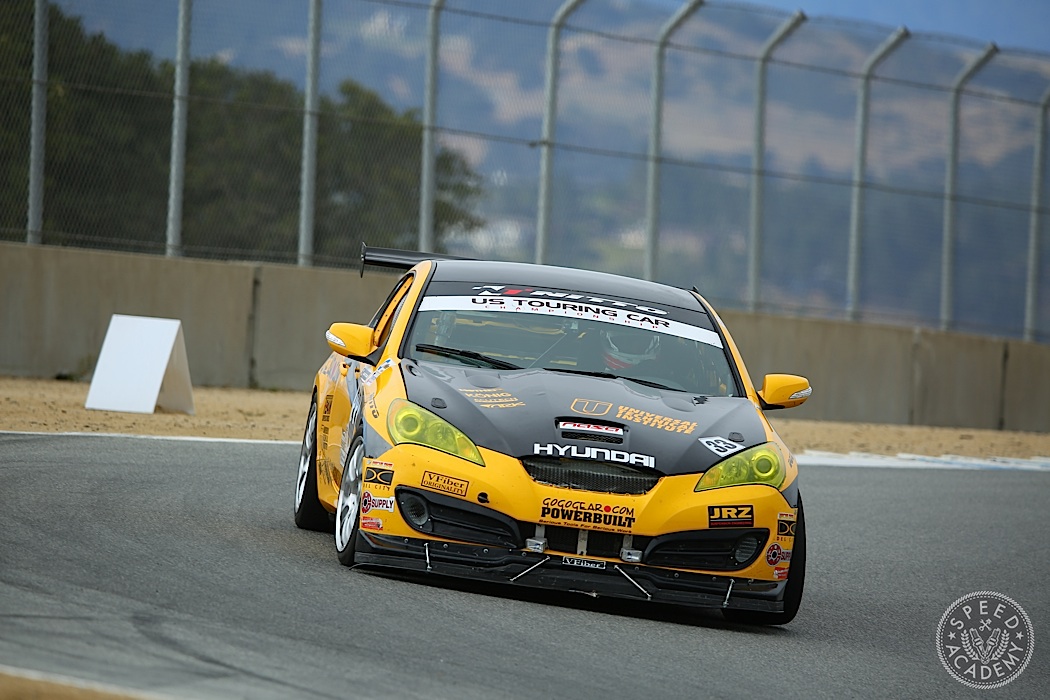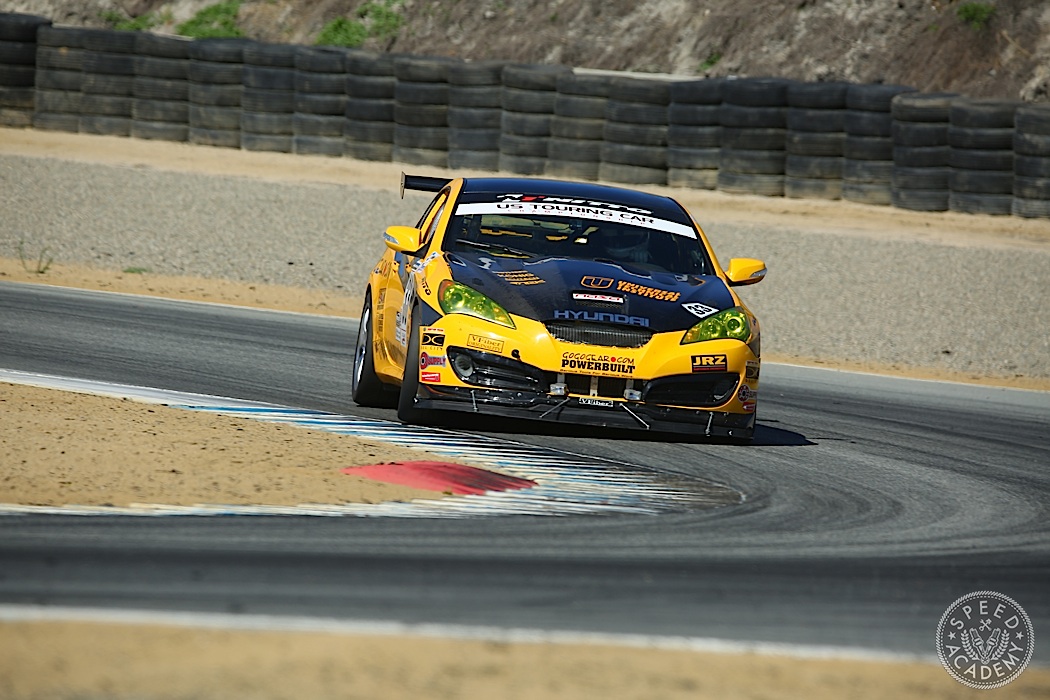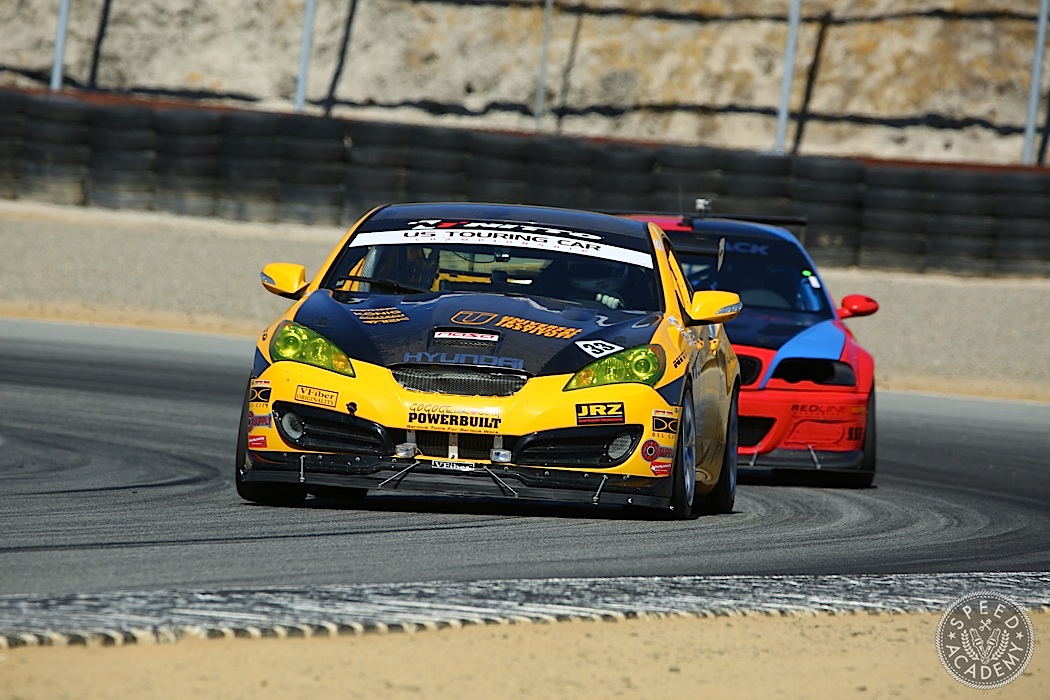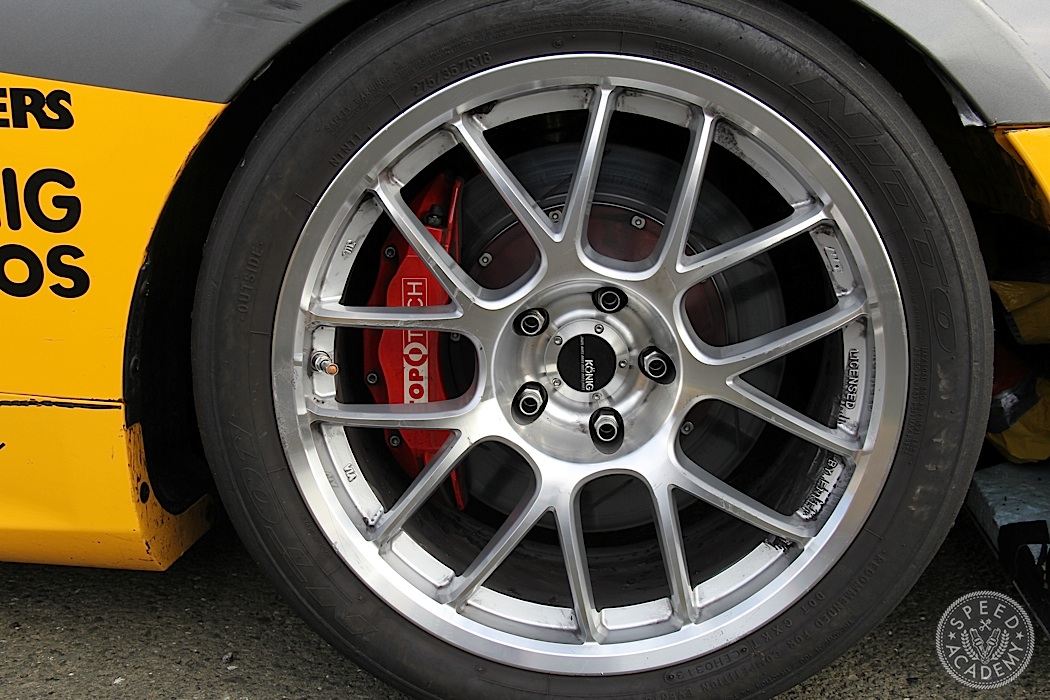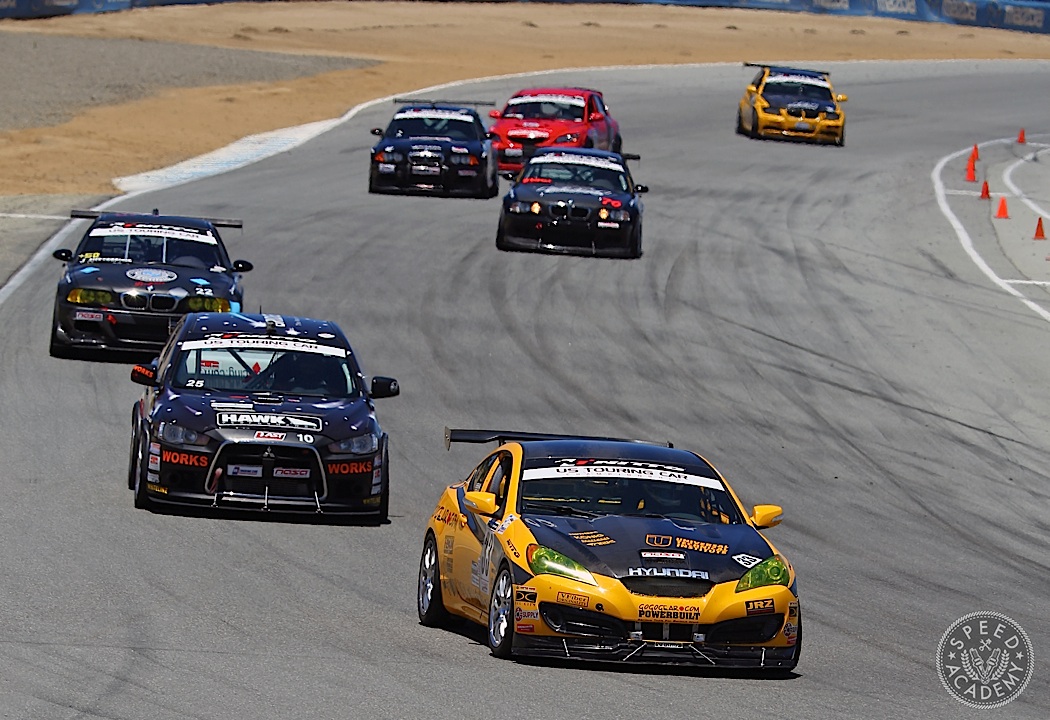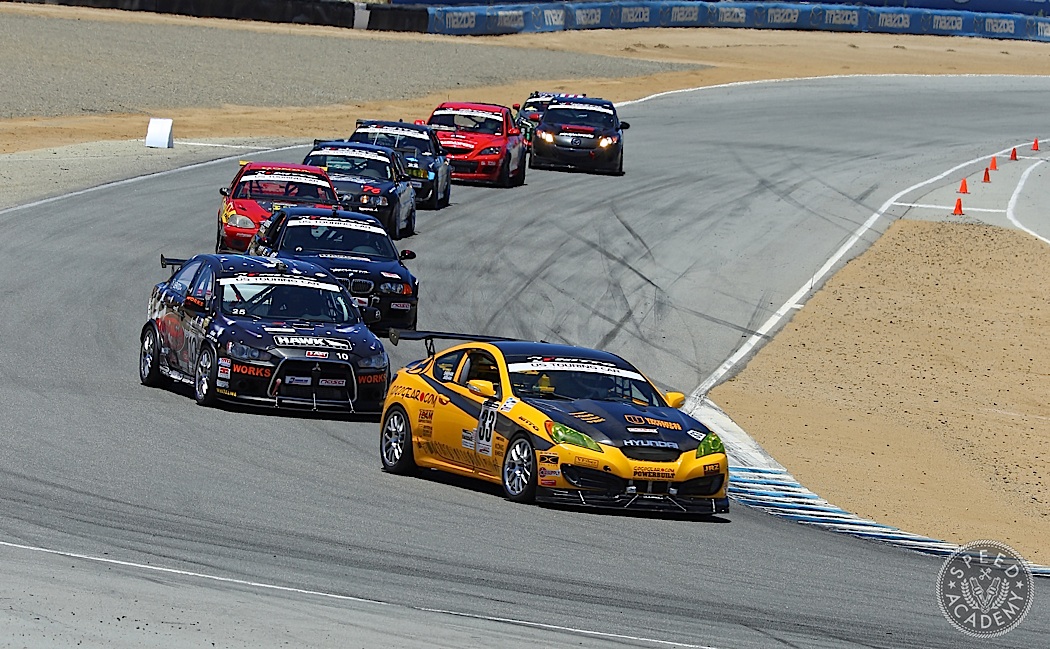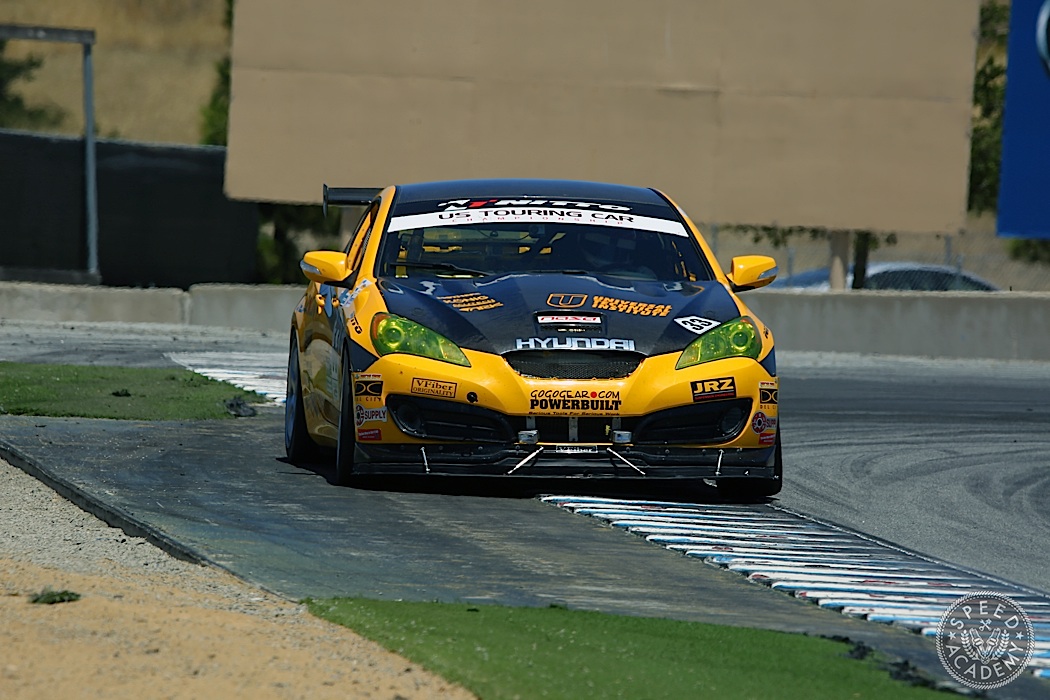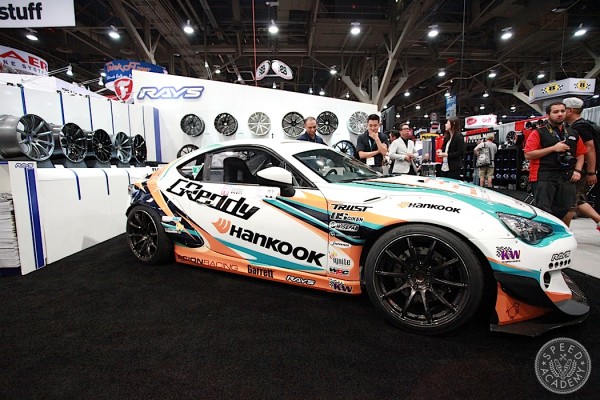After being briefed on the cockpit controls and starting procedures, I willingly fired up the engine. The sound that emanated from the custom made Magnaflow dual-exhaust caught me by surprise. It was raspy, throaty and loud. A few blips of the throttle brought forth a deep roar that encouraged more of the same. I obliged by engaging first gear and rolled down the paddock to start my first laps. Some racing clutches can be a bit abrupt, trading smooth engagement for ultimate clamping force. I was impressed by the smooth engagement of Spec Clutch racing clutch, which provided great feel while handling the torque of the Hyundai’s big V6.
As I cruised through the paddock on my way to pit lane I encountered a little issue with the throttle. Whacking the throttle in the pits to hear the engine is one thing, but the gentle throttle inputs required in the paddock requires a light touch. Unfortunately, the throttle wasn’t responding to my finesse. For some reason throttle tip-in took a lot of force to overcome, then once overcome, the effort to move the throttle further was nearly nonexistent. This made for some embarrassing lurching any time I tried to increase throttle a tiny bit. I’d be coasting slower and slower, trying to give just a little throttle to maintain paddock speed, all of a sudden break through the resistance and leap forward with a loud “BRAAP!!”. It was impossible to drive the car around the pits smoothly and made me feel pretty foolish!
Once I got out on track and went wide-open throttle, I was pleasantly surprised with how forcefully I was shoved back into the seat with the exhaust sounding off impressively with its sweet sound. I hadn’t driven a rear-wheel-drive race car with a naturally aspirated engine for quite some time, but I was instantly back at home with where I got my racing career started. While turbo powered engines can create a lot of horsepower over a wide powerband, they tend to come on hard and non-linearly with throttle input. The advantage of an NA engine is its gradual and linear onset of power, a given throttle input generates a consistant and linear power output. In a RWD NA car, this makes the throttle a useable driver control rather than an on/off switch for making the car go faster.
The Hyundai Genesis’s combination of rear wheel drive and NA power made it a fast car, and a FUN car to drive fast. The balance of the chassis was quite good, with predictable turn-in under trail braking, neutral balance in mid-corner and sweet corner exit behavior where the front of the car can be controlled with the steering wheel and the back of the car with the throttle. There is so much more you can do with a car when you can steer the car from either end with different inputs! The Genesis transitioned smoothly and predictably into oversteer when urging the car forward a bit too enthusiastically with the right foot. The oversteer was very progressive and easy to bring back with little fuss, however, the back of the car did seem to stay out longer than I would have expected. I would have liked to spend more time with the car to play with the rear JRZ dampers to make the rear of the car step back into formation a little quicker. JRZ dampers have excellent adjustability and I have no doubt that I would have been able to get the rear of the car dialed-in to my liking.
The suspension has QA1 rod bearings in all of the stock positions, which removes suspension compliance and gives precise suspension movement. Megan Racing adjustable links were installed in the rear to provide a wide range of alignment adjustability. Beck Arnley OEM replacement wheel bearings that meet or exceed the Hyundai requirements were installed to replace the stock bearings. H&R Springs wheel spacers pushed the 18” Konig Kilograms wheels out just enough for the meaty 275/35R18 Nitto NT01’s to clear the fenders.
I had been briefed that there were some recent issues with the braking system that did not exist earlier in the car’s career, and unfortunately found that this was the case. Effective and predictable brakes are a requirement for inspiring driver confidence. Without this, the driver is always second guessing the car as he enters a braking zone, not trusting the brakes to wait until the last few inches before jumping on them. There were a couple of issues that I identified within the first few laps. The first was one that I’d experienced several times in my racing career; brake-pad knock back. This tends to happen with fixed caliper braking systems more than in floating caliper systems, because a fixed caliper brake has no side to side compliance and zero tolerance for any flexibility in the upright or the hub. Any flex that allows the rotor to move axially against the brake pads pushes the pads back into the caliper. The next time the driver attempts to brake, the pedal moves excessively because a lot of brake fluid is required to push the pistons out and get the pad face back in touch with the rotor.
This problem is an easy issue to drive around. Simply pump the brakes once with your left foot while maintaining full-throttle prior to the braking zone. When you transition from throttle to brakes with your right foot, the pads will be in contact with the rotors and normal and confidence inspiring braking occurs. Unfortunately, this wasn’t the only issue. There was an inconsistency in the ABS system that caused drastically different deceleration rates in the same braking zone with the same brake pedal effort. So one time I would go into a braking zone and everything would be normal, and the next lap the pedal would be incredibly firm and the car would hardly slow at all. The next lap the pedal would be soft and travel far, but provide decent braking. This is typically a very unsettling experience for the driver and robs the driver of the confidence needed to push the car hard into the braking zones. I was further disappointed to find that nothing I changed in my braking technique (pedal pressure, onset rate, etc.) had any impact on the inconsistency.
This is probably the biggest area of advancement for this car. It is a recent problem and troubleshooting is in order to determine what changed to cause this. Mechanically, the Stoptech braking system is fantastic. Big 355mm front rotors with 6-piston Stoptech ST-60 calipers up front incorporating pistons sized specifically to match the OEM rear brakes. Stoptech tailors their big brake kit pistons to optimize brake balance and braking efficiency. I’ve had a lot of success on Stoptech brakes and I am convinced this is the right set-up for the Genesis. Once the team resolves the ABS gremlin, this is going to be one of the fastest stopping cars in USTCC.
Overall I was very impressed with the car. It was a lot of fun and easy to drive the car fast with no evil handling characteristics and very forgiving when taken past the limit of adhesion. The power feels strong and power deliver is smooth and predictable. The front engine, rear wheel drive and naturally aspirated engine configuration is a tried and true combination that will perform consistently throughout a full race distance and across a wide range of ambient temperature. Unlike many touring cars, this car seems to have very little compromise with respect to handling and balance. In fact, I think once the ABS braking issue is resolved and with some incremental chassis development, the GoGoGear.com Hyundai Genesis could be a USTCC championship contender.
Now I just have to figure out a way to be asked to drive this car again!
